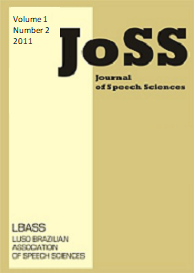Abstract
In current speech rhythm research, the traditional search for isochrony and speech rhythm classes has been replaced with a focus on uncovering the acoustic correlates of rhythm in the speech signal (Ramus, Nespor, and Mehler 1999, Grabe and Low 2002, Cummins 2002). In this paper, I present findings from a study in which I describe speech rhythm in a language whose rhythm had not been previously studied—Ashanti Twi (Niger-Congo, Kwa). Additionally, I test the validity of claims made about the utility of various rhythm metrics. Two native speakers of Ashanti Twi participated in the study. Each speaker was recorded while reading a translation of “The North Wind and the Sun”. Vocalic and consonantal intervals were measured in Praat using auditory and visual cues. Various rhythm metrics (interval measurements and Pairwise Variability Indices) were then computed and compared to results from prior studies. Results show that Ashanti Twi is rhythmically more similar to languages that have been traditionally described as syllable-timed, such as French and Spanish. However, it does not fall clearly into the traditional stressor syllable-timed categories, supporting the claim that speech rhythm should be studied as a continuum rather than a categorical distinction.
References
Abercrombie, David. 1967. Elements of General Phonetics. Edinburgh: Edinburgh University Press.
Barbosa, Plínio, 2002. Explaining cross-linguistic rhythmic variability via a coupled-oscillator model of rhythm production. In Proceedings of the Speech Prosody 2002 Conference, Aix-en-Provence. 163–166.
Barbosa, Plínio, M. CéuViana, and Isabel Trancoso, 2009. Cross-variety rhythm typology in Portuguese. In INTERSPEECH-2009.Brighton. 1011–1014.
Classe, Andre. 1939. The rhythm of English prose. Oxford: Blackwell.
Cummins, Fred. 2002. Speech Rhythm and Rhythmic Taxonomy. In Proceedings of the Speech Prosody 2002 Conference. Aix-en-Provence, France.
Cummins, Fred and Robert F. Port. 1998. Rhythmic constraints on stress timing in English. Journal of Phonetics26. 145–171.
Dauer, Rebecca M. 1983. Stress-timing and syllable-timing reanalyzed. Journal of Phonetics11. 51-62.
Dauer, Rebecca M. 1987. Phonetic and Phonological Components of Language Rhythm. In Proceedings of the Eleventh International Congress of Phonetic Sciences. 447-450. Tillinn, Estonia.
Dellwo, Volker. 2006. Rhythmand speech rate: A variation coefficient for ΔC. In Karnowski, P. and I. Szigeti (Eds.), Language and language processing: Proceedings of the 38thlinguistic colloquium. 231-241. Frankfurt: Peter Lang.
Den Os, E. 1988.Rhythm and Tempo of Dutch and Italian,Utrecht: Drukkerij Elinkwijk.
Dimitrova, Snezhina. 1998. Bulgarian Speech Rhythm: Stress-Timed or Syllable-Timed? Journal of the International Phonetic Association27. 27-33.
Dolphyne, Florence A. 1988. The Akan (Twi-Fante) Language: Its Sound System and Tonal Structure. Accra: Ghana Universities Press.
Grabe, Esther and Ee Ling Low. 2002.Durational variability and speech rhythm. In Gussenhoven, C. and Warner (eds.), Laboratory Phonology 7. N. Berlin: Mouton de Gruyter.
Gut, Ulrike, Eno-Abasi Urua, Sandrine Adouakou and Dafydd Gibbon. 2001. Rhythm in West African tone languages: a study of Ibibio, Anyi and Ega. In Proceedings of the Typology of African Prosodic Systems Workshop. Bielefeld University, Germany.
Gut, Ulrike and J.T. Milde. 2002. The prosody of Nigerian English. In B. Bel and I. Marlien (eds.) In Proceedings of the Speech Prosody 2002 Conference. Aix-en-Provence, France.
Kohler, Klaus J. 2009. Rhythm in speech and Language: A New Research Paradigm. Phonetica66. 29-45.
Lewis, M. Paul (Ed.), 2009. Ethnologue: Languages of the World, Sixteenth edition. Dallas, Tex.: SIL International. Online version: http://www.ethnologue.com/.
Loukina, Anastassia, Greg Kochanski, Chilin Shih, Elinor Keane, and Ian Watson. 2009. Rhythm measures with language-independent segmentation. In INTERSPEECH 2009. Brighton. 1531-1534.
Low, Ee Ling and Esther Grabe. 1995. Prosodic patterns in Singapore English. Proceedings of the XIIIth International Congress of Phonetic Sciences3. Stockholm. 636-639.
Marfo, Charles and Solace Yankson. 2008. The Structure of the CCV Syllable of Akan. Concentric: Studies in Linguistics34(2). 85-100.
Nazzi, Thierry, Josiane Bertoncini, and Jacques Mehler. 1998. Language discrimination by newborns: towards an understanding of the role of rhythm. Journal of Experimental Psychology: Human Perception and Performance24. 756–766.
O‘Dell, Michael and Tommi Nieminen, 2009. Coupled oscillator model for speech timing: Overview and examples. In: Vainio, M., Aulanko, R., Aaltonen, O. (Eds.), In Nordic Prosody: Proceedings of the Xth Conference, Helsinki 2008.
O‘Dell, Michael and Tommi Nieminen, 1999. Coupled oscillator model of speech rhythm. In: Ohala, J., Hasegawa, Y., Ohala, M., Granville, D., Bailey, A. (Eds.), In Proceedings of the XIVth International Congress of Phonetic Sciences. Vol. 2. University of California, Berkeley. 1075–1078.
Ofori, Seth. 2006. Akan Hypocorisms: A Constraint-Based Approach. In Obeng, Samuel Gyasi and Cecilis Sem Obeng (Eds.). From Linguistics to Cultural Anthropology: Aspects of Language, Culture and Family Issues in Ghana (West Africa). Meunchen: LINCOM GmbH. 67-86.
Peterson, Gordon E. and Ilse Lehiste. 1960. Duration of Syllable Nuclei in English. The Journal of the Acoustical Society of America 32(6). 693-703.
Pike, Kenneth. 1945. The Intonation of American English. 2ndedition. Ann Arbor: University of Michigan Press.
Port, Robert F., Jonathan Dalby, and Michael O‘Dell. 1987. Evidence for mora timingin Japanese. Journal of the Acoustical Society of America81. 1574-1585.
Ramus, Franck, Marina Nespor, and Jacques Mehler. 1999. Correlates of linguistic rhythm in the speech signal. Cognition73. 265-292.
Roach, Peter. 1982. ―On the distinction between 'stress-timed' and 'syllable-timed' languages.‖ In Crystal, David (ed.). Linguistic Controversies. 73-79.
Roach, Peter 1998 ―Some Languages are Spoken More Quickly Than Others‖ inLanguage Myths, eds. L. Bauer and P. Trudgill, Penguin, 1998, pp. 150-8.
White, Laurence and Sven L. Mattys. 2007. Calibrating rhythm: First language and second language studies. Journal of Phonetics35. 501-522.

This work is licensed under a Creative Commons Attribution 4.0 International License.
Copyright (c) 2011 Ann Marie Olivio

